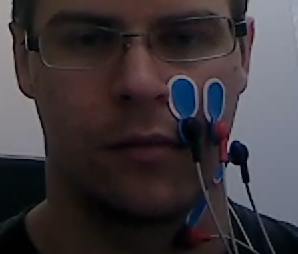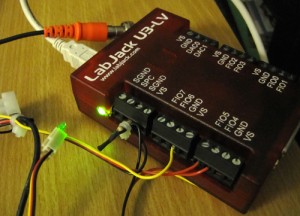Recording EMG, Sending Event Pulses with LabJack
[](http://blog.ninlabs.com/wp-content/uploads/2010/06/subvocal.png) [](http://blog.ninlabs.com/wp-content/uploads/2010/06/labjack.jpg)
[](http://blog.ninlabs.com/wp-content/uploads/2010/06/labjack.jpg)
When recording EMG signals, you want to be able to segment and associate those signals with certain events, e.g., the presentation of a stimuli. Because one of my goals is to recognize subvocalized words, it is even more important to get tight segmentation.
Here, we have an test audio signal (blue) and one channel of the corresponding EMG signal (biege). I had to manually line this up, and have little confidence if it is correct.
Luckily, one the EMG devices I’m using supports sending events into the EMG stream to leave “marks” in the signal. Using a Labjack device, I can send a digital pulse to the EMG recording device.
Now, I have another channel with event marks!
C# Code for Labjack.
static System.Timers.Timer Timer;
internal static void SendSignal()
{
//Set digital output FIO4 to output-high.
LJUD.AddRequest(Connection.ljhandle, LJUD.IO.PUT_DIGITAL_BIT, 4, 1, 0, 0);
//Set digital output FIO5 to output-high.
LJUD.AddRequest(Connection.ljhandle, LJUD.IO.PUT_DIGITAL_BIT, 5, 1, 0, 0);
//Execute the requests.
LJUD.GoOne(Connection.ljhandle);
Timer = new System.Timers.Timer(20);
Timer.Elapsed += delegate(object sender, System.Timers.ElapsedEventArgs e)
{
Timer.Enabled = false;
Timer = null;
LJUD.AddRequest(Connection.ljhandle, LJUD.IO.PUT_DIGITAL_BIT, 5, 0, 0, 0);
LJUD.AddRequest(Connection.ljhandle, LJUD.IO.PUT_DIGITAL_BIT, 4, 0, 0, 0);
LJUD.GoOne(Connection.ljhandle);
};
Timer.Start();
}
blog comments powered by Disqus


